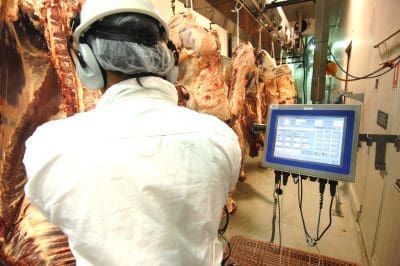NATIONAL weekly cattle slaughter continues to rise heading into winter, but it’s looking increasingly like the processing sector’s natural capacity given current staffing levels is close to being filled.
Last week’s seven-day national kill was the largest of the year at 138,200 head, boosted by some fine weather and removal of other supply obstacles, like producer attendance at the Beef 2024 event.
 Kills have gradually increased since the start of March, with the past four full working weeks (holidays excluded) averaging well over 135,000 head. That’s about 20,000 head more than the same four equivalent full weeks last year. Weekend and overtime shifts at some plants are contributing. Others are simply ‘adding an extra hundred here and there’ to existing rosters to try to keep up with demand.
Kills have gradually increased since the start of March, with the past four full working weeks (holidays excluded) averaging well over 135,000 head. That’s about 20,000 head more than the same four equivalent full weeks last year. Weekend and overtime shifts at some plants are contributing. Others are simply ‘adding an extra hundred here and there’ to existing rosters to try to keep up with demand.
A run of fine weather is helping on the delivery side, and early frosts are coaxing owners in some areas to make marketing decisions.
However current labour capacity suggests that even with some overtime production, the industry’s current production capacity sits at around 140,000 head – a figure now well within sight. And traditional mid-year maintenance stoppages at some sites won’t help ease the burden.
With those statistics in mind, June is now shaping as a period of high turnoff in northern parts of Australia, which should signal an amber or red light in terms of slaughter cattle price. Once slaughter cattle supply exceeds processors ability to turn them into boxed beef, market forces must inevitably take hold.
While it’s not particularly relevant right now, there’s also some underlying concerns evident among processors about what happens, should conditions turn dry. The system is struggling to cope now, let alone when there are greater numbers of cull cows and other cattle being jettisoned should conditions start to really dry-off, they say.
 Even with the presence of southern-states processors in Queensland since earlier this month, it’s looking increasingly likely that at some point soon supply in the northern half of the country will exceed fabrication capacity.
Even with the presence of southern-states processors in Queensland since earlier this month, it’s looking increasingly likely that at some point soon supply in the northern half of the country will exceed fabrication capacity.
Several processors told Beef Central they have had conversations recently with regular large suppliers of direct consignment cattle where the vendor has nominated a delivery date in early June, only to find those slots are already filled. While some competitors appear genuinely concerned about the risk of mid-year oversupply of cattle, others are not yet at that level. A livestock manager for one large Queensland shed said he still had reasonable booking space available for week ending 16 June.
Early frosts are certainly playing a part, with vendors making marketing decisions based on deterioration in feed quality. Countering that a little, there is often a brief lull in slaughter supply heading deeper into June, as tax considerations come into play for some producers, holding stock over until the start of the new financial year.
Direct consignment grids steady
Most direct consignment slaughter grids are unchanged this week, after some 10-20c/kg rises in offers a week earlier across southern Queensland and northern NSW.
In southern Queensland, competitive processors this week have good quality heavy cows at 450-460c/kg and four-tooth grass ox at 520-530c/kg with implant. Certified Grassfed steer offers in southern QLD are around 600c. Prices are unchanged in Central and North Queensland, having dropped 10c/kg in Townsville the previous week, in line with plentiful local regional supply and live export price movements.
Feeder cattle prices have found a level of stability in recent weeks, with good heavy flatback feeders ex Downs to be had for prices around 335-340c this week.
Further south, we’ve seen slaughter grids in southern NSW this morning offering 570c/kg on four-tooth ox, having risen 10c the previous week, with cows unchanged on 480c. Eastern regions of South Australia are unchanged with offers of 550c on ox and 520c on cows. Lack of rain in the region is a factor.
As described last week, southern states operators have continued to operate strongly in Queensland selling centres over the past seven days, with northern weight and grade cattle now looking relatively cheap, compared with prices at home. A shortage of good slaughter cattle out of NSW and eastern parts of SA as the season has deteriorated further south is helping fan the flames.
WFA adds value
In other conversations with processor cattle buyers this week, one remarked on the weight-for-age evident in Queensland grass bullock turnoff in recent months. That should come as no great surprise, given the sequence of better than average seasons in many areas, but he suggested the larger proportion of two-tooth, export ox to four and six teeth was clearly evident in recent kills.
Processors typically pack 0-2 tooth grass on in one carton, and four-tooth (PR cipher) ox in another, with a 10c/kg difference in carcase price. So in theory, a Queensland grass producer selling predominantly two tooth ox this year instead of four is picking up an additional $35/head on the same carcase weight animal, based solely on WFA and dentition alone.
Production numbers
As mentioned above, last week’s seven-day national kill recorded by NLRS hit a 2024 season high of 138,200 head, about 16pc higher than the same week last year.
Biggest growth is being seen in Queensland (now consistently above 70,000 per week) and Victoria (continuing to climb, reaching a season high of 20,686 head last week). South Australia (3400 last week) has not yet started to show its normal seasonal decline in numbers heading into winter, however Western Australia has now come off sharply compared with kills seen in mid-late March, as the state enters its winter lull in production. Last week’s WA kill of 2772 head was down 21pc on typical pre-Easter levels.
NSW has had consistently steady kills since mid-February around 34,000 head, while Tasmanian numbers have also been consistent, at around 5000 head, since the start of the year.
Saleyards numbers surge
There’s been a surge in saleyard numbers offered across Eastern Australia early this week.
Gunnedah numbers this morning jumped 54pc from last week to 2400 head. Grown steers with two or more teeth sold to cheaper trends, while there were cheaper trends also through the cow market with the heavy high yielding lots least affected.
Today’s Roma store sale (sale still in progress – full results published tomorrow) is offering 8712 head, up 78pc on last week.
Even smaller centres like Charters Towers in North Queensland are offering 2400 fat cattle tomorrow.
